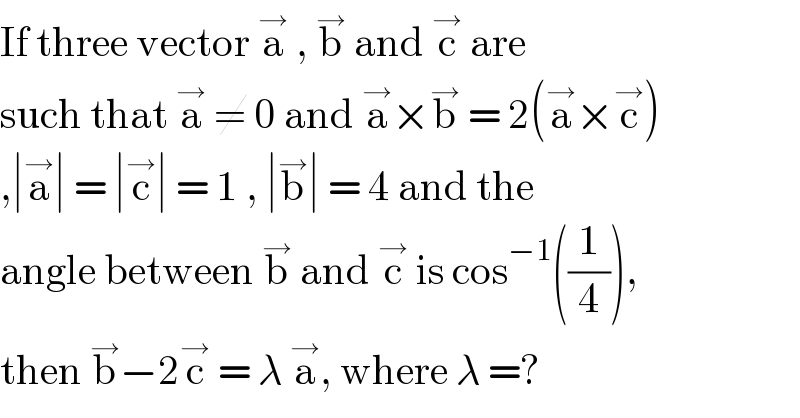
Question Number 140502 by benjo_mathlover last updated on 08/May/21

$$\mathrm{If}\:\mathrm{three}\:\mathrm{vector}\:\overset{\rightarrow} {\mathrm{a}}\:,\:\overset{\rightarrow} {\mathrm{b}}\:\mathrm{and}\:\overset{\rightarrow} {\mathrm{c}}\:\mathrm{are}\: \\ $$$$\mathrm{such}\:\mathrm{that}\:\overset{\rightarrow} {\mathrm{a}}\:\neq\:\mathrm{0}\:\mathrm{and}\:\overset{\rightarrow} {\mathrm{a}}×\overset{\rightarrow} {\mathrm{b}}\:=\:\mathrm{2}\left(\overset{\rightarrow} {\mathrm{a}}×\overset{\rightarrow} {\mathrm{c}}\right) \\ $$$$,\mid\overset{\rightarrow} {\mathrm{a}}\mid\:=\:\mid\overset{\rightarrow} {\mathrm{c}}\mid\:=\:\mathrm{1}\:,\:\mid\overset{\rightarrow} {\mathrm{b}}\mid\:=\:\mathrm{4}\:\mathrm{and}\:\mathrm{the}\: \\ $$$$\mathrm{angle}\:\mathrm{between}\:\overset{\rightarrow} {\mathrm{b}}\:\mathrm{and}\:\overset{\rightarrow} {\mathrm{c}}\:\mathrm{is}\:\mathrm{cos}^{−\mathrm{1}} \left(\frac{\mathrm{1}}{\mathrm{4}}\right), \\ $$$$\mathrm{then}\:\overset{\rightarrow} {\mathrm{b}}−\mathrm{2}\overset{\rightarrow} {\mathrm{c}}\:=\:\lambda\:\overset{\rightarrow} {\mathrm{a}},\:\mathrm{where}\:\lambda\:=? \\ $$
